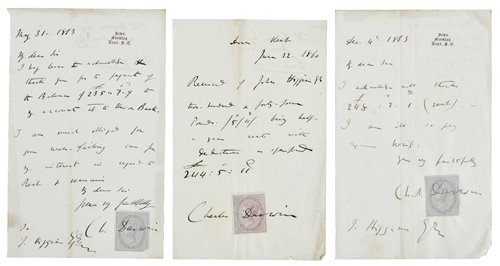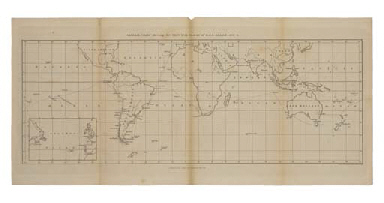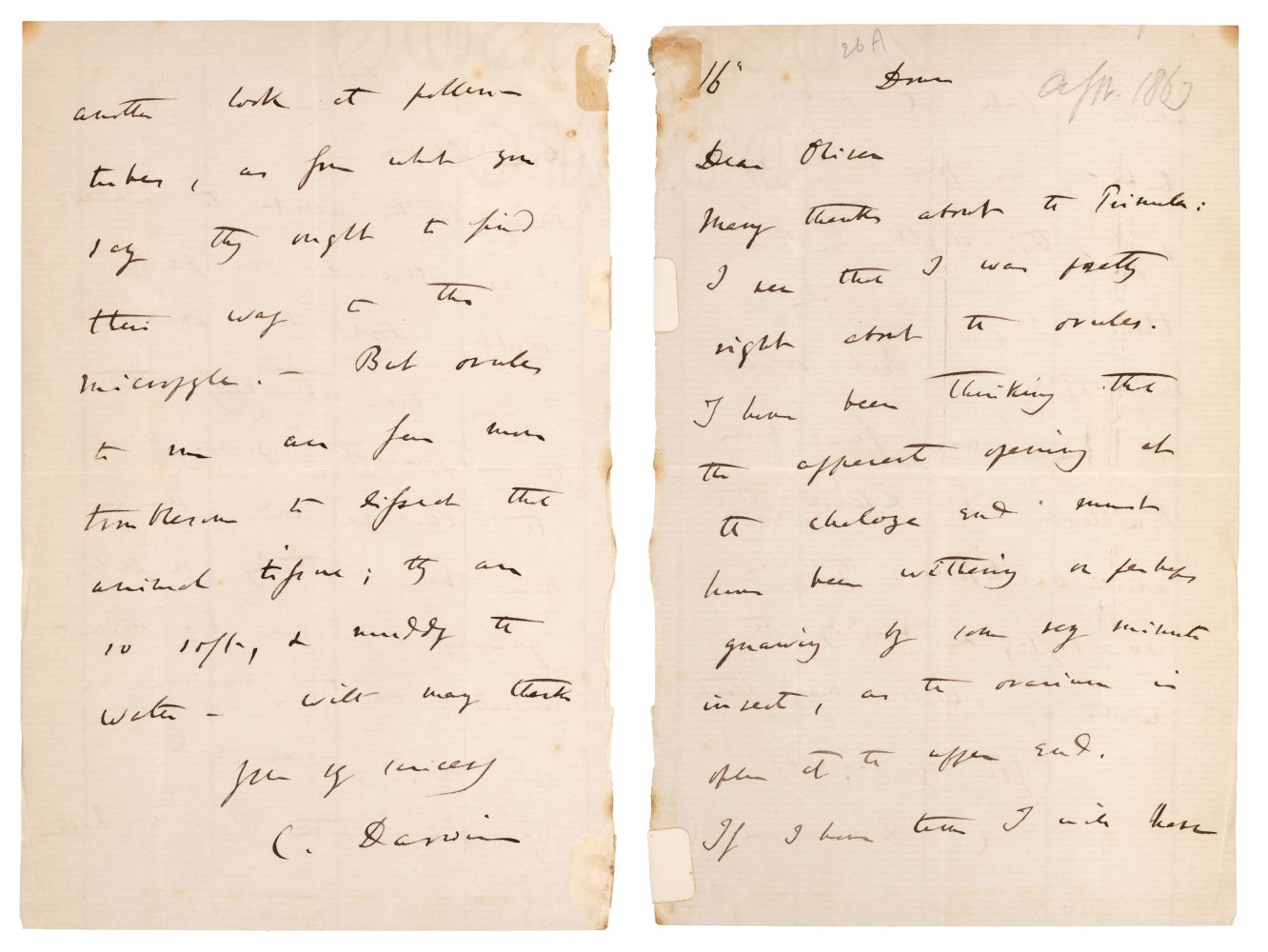DARWIN, Charles Robert (1809-1882). The Structure and Distribution of Coral Reefs: being the first part of the Geology of the Voyage of the Beagle . London: Smith, Elder and Co., 1842. 8° (221 x 140mm). 3 folding engraved maps, 2 hand-coloured in outline, 6 woodblocks in text. 16p. publisher's advertisements, dated May 1842, inserted at end. (Frontispiece map creased and with short marginal tear, uncoloured map lightly browned.) Original blue cloth, covers blind-stamped, spine titled and priced in gilt (spine faded and frayed at head and foot). Provenance : CAROLINE WEDGWOOD (initials on title). FIRST EDITION, CAROLINE WEDGWOOD'S COPY. Charles's sister knew at first hand of the genesis and torturingly slow progress of his most important geological work. He thought out his theory of coral formation on the west coast of South America before ever seeing a coral reef, telling her at the end of April 1836: 'The subject of coral formation has for the last half year, been a point of particular interest to me. I hope to be able to put some of the facts in a more simple & connected point of view, than that in which they have hitherto been considered. The idea of a lagoon island, 30 miles in diameter being based on a submarine crater of equal dimensions, has always appeared to me a monstrous hypothesis' ( Correspondence I, p. 495). In place of the unseen volcanic craters conjectured by Lyell, Darwin substituted land subsidence or elevation, a theory of geological ups and downs entirely in keeping with Lyell's broader views. However, the eventual writing up of his observations was a long drawn-out and at times tedious task. In a letter to Caroline from 12 Upper Gower St, London, 27 October 1839, the newly-married Darwin described his daily routine for working on Coral Reefs : 'One of my days is as like another as two peas. -- as you say you want to know all about us -- I will give you a specimen; which will serve for every day -- Get up punctually at seven leaving Emma dreadful sleepy & comfortable, set to work after the first torpid feeling is over, and write about coral formations till ten; go up stairs & find that Emma has been down stairs about half an hour, eat our breakfast, sit in our arm-chairs -- and I watch the clock as the hand travels sadly too fast to half past eleven -- Then to my study and work till 2 o'clock luncheon time: Emma generally comes and does a little work in my room and sits as quiet as a mouse ....' ( Correpondence , II, p. 236). The cost of the book and time expended on it continued to exasperate the author who wrote to Emma, 9 May 1842: 'I am stomachy & be blue deviled. I am daily growing very very old, very very cold & I daresay very sly. -- I will give you statistics of time spent on my coral-volume, not including all the work on board the Beagle -- I commenced it 3 years & 7 months ago, & have done scarcely anything besides -- I have actually spent 20 months out of this period on it! & nearly all the remainder sickness & visiting!!!' ( Correspondence II, p. 318). Darwin's journal records that he sent the manuscript to the printers on 3 January 1842, and corrected the last proof on 6 May before journeying to Maer. Four colours were used for the maps, representing three types of reef and active volcanoes (see his letter to Lyell, 6 July 1841). A second edition, extensively revised in the light of later findings, appeared in 1874. Freeman 271; Norman 587.
DARWIN, Charles Robert (1809-1882). The Structure and Distribution of Coral Reefs: being the first part of the Geology of the Voyage of the Beagle . London: Smith, Elder and Co., 1842. 8° (221 x 140mm). 3 folding engraved maps, 2 hand-coloured in outline, 6 woodblocks in text. 16p. publisher's advertisements, dated May 1842, inserted at end. (Frontispiece map creased and with short marginal tear, uncoloured map lightly browned.) Original blue cloth, covers blind-stamped, spine titled and priced in gilt (spine faded and frayed at head and foot). Provenance : CAROLINE WEDGWOOD (initials on title). FIRST EDITION, CAROLINE WEDGWOOD'S COPY. Charles's sister knew at first hand of the genesis and torturingly slow progress of his most important geological work. He thought out his theory of coral formation on the west coast of South America before ever seeing a coral reef, telling her at the end of April 1836: 'The subject of coral formation has for the last half year, been a point of particular interest to me. I hope to be able to put some of the facts in a more simple & connected point of view, than that in which they have hitherto been considered. The idea of a lagoon island, 30 miles in diameter being based on a submarine crater of equal dimensions, has always appeared to me a monstrous hypothesis' ( Correspondence I, p. 495). In place of the unseen volcanic craters conjectured by Lyell, Darwin substituted land subsidence or elevation, a theory of geological ups and downs entirely in keeping with Lyell's broader views. However, the eventual writing up of his observations was a long drawn-out and at times tedious task. In a letter to Caroline from 12 Upper Gower St, London, 27 October 1839, the newly-married Darwin described his daily routine for working on Coral Reefs : 'One of my days is as like another as two peas. -- as you say you want to know all about us -- I will give you a specimen; which will serve for every day -- Get up punctually at seven leaving Emma dreadful sleepy & comfortable, set to work after the first torpid feeling is over, and write about coral formations till ten; go up stairs & find that Emma has been down stairs about half an hour, eat our breakfast, sit in our arm-chairs -- and I watch the clock as the hand travels sadly too fast to half past eleven -- Then to my study and work till 2 o'clock luncheon time: Emma generally comes and does a little work in my room and sits as quiet as a mouse ....' ( Correpondence , II, p. 236). The cost of the book and time expended on it continued to exasperate the author who wrote to Emma, 9 May 1842: 'I am stomachy & be blue deviled. I am daily growing very very old, very very cold & I daresay very sly. -- I will give you statistics of time spent on my coral-volume, not including all the work on board the Beagle -- I commenced it 3 years & 7 months ago, & have done scarcely anything besides -- I have actually spent 20 months out of this period on it! & nearly all the remainder sickness & visiting!!!' ( Correspondence II, p. 318). Darwin's journal records that he sent the manuscript to the printers on 3 January 1842, and corrected the last proof on 6 May before journeying to Maer. Four colours were used for the maps, representing three types of reef and active volcanoes (see his letter to Lyell, 6 July 1841). A second edition, extensively revised in the light of later findings, appeared in 1874. Freeman 271; Norman 587.

.jpg)





.jpg)
.jpg?w=400)
.jpg?w=400)



.jpg)
.jpg)
Try LotSearch and its premium features for 7 days - without any costs!
Be notified automatically about new items in upcoming auctions.
Create an alert